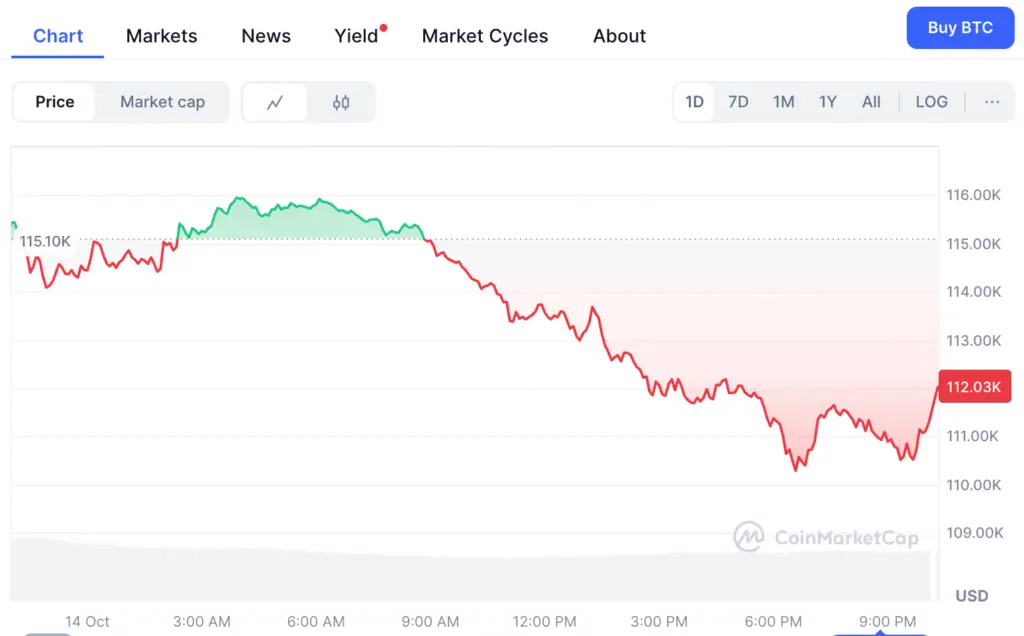Bitcoin Experiences a Dip Following New All-Time High
Bitcoin has experienced a significant decline after reaching an all-time high exceeding $126,000 earlier this month, as reported by CoinMarketCap data. The cryptocurrency experienced a decline of nearly 9%, dropping to approximately $114,000, which has sparked fresh conversations among long-term investors.
Even with the recent pullback, excitement surrounding Bitcoin continues to thrive as traders evaluate whether this correction represents a period of consolidation or indicates the onset of another cyclical decline as we approach 2026.

Historical Cycles Suggest a Possible Major Correction
The price history of Bitcoin reveals distinct four-year cycles linked to its halving events. Historically, every halving has been followed by a significant rally, which is then often succeeded by a sharp decline.
The asset experienced a decline of 61% in 2014, 73% in 2018, and 64% in 2022, resulting in an average decrease of 66% every four years. Should the trend continue, experts caution that a comparable adjustment could take place in 2026.
Bitcoin’s Halving Mechanism Drives Predictable Supply and Price Cycles
The distinctive issuance structure of Bitcoin serves as the main catalyst for its price fluctuations. At every 210,000 mined blocks, the network systematically reduces miner rewards by half, thereby decreasing the rate of supply growth.
Miners now earn 3.125 BTC for each block, a decrease from the more generous rewards of the past. This process reduces Bitcoin’s inflation rate and modifies the equilibrium between new supply and market demand every four years.
Recommended Article: Strategy Expands Bitcoin Holdings With $27.2 Million Purchase
The 2024 Halving and Its Ripple Effects
The most recent halving occurred in 2024, further decreasing new issuance. In the past, Bitcoin prices have shown an upward trend before and after halving years, often accompanied by subsequent corrections.
With 2026 on the horizon, experts are keenly observing whether Bitcoin will manage to break free from its recurring pattern or if history will repeat itself once more.
Bitcoin May Avoid Major Crash as Liquidity Expands and Rates Decline
Certain experts suggest that Bitcoin could potentially sidestep a crash in 2026, thanks to enhanced macroeconomic conditions. Arthur Hayes, a notable figure in the cryptocurrency realm, indicates that the monetary landscape has evolved to benefit Bitcoin.
He observes that the U.S. M2 money supply is currently on the rise, and interest rates are anticipated to decrease next year, which could lead to a more advantageous liquidity landscape for digital assets.
Institutional Adoption May Support Bitcoin Prices
The fundamentals of Bitcoin have undergone considerable evolution since earlier cycles. In 2014, the market capitalization was under $10 billion, while today it surpasses $2.3 trillion.
There has been a notable increase in institutional investment, as sovereign funds, ETFs, and corporate treasuries now consider Bitcoin a reserve asset. The increasing recognition of this trend could bolster demand and provide a buffer against potential future corrections.
Investors Cautious as Bitcoin Faces Potential Cyclical Decline in 2025
Certain investors are exercising caution, expecting a cyclical decline that aligns with Bitcoin’s historical patterns. They contend that even widespread adoption cannot completely eliminate historical patterns.
Some hold the view that increasing global involvement, enhancing liquidity, and fostering institutional integration may support Bitcoin’s value up to 2026. The upcoming year could be pivotal in deciding if Bitcoin genuinely transcends its four-year cycle.















